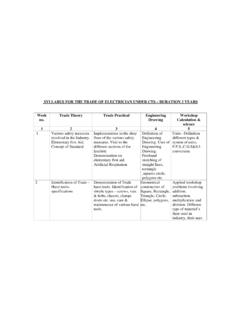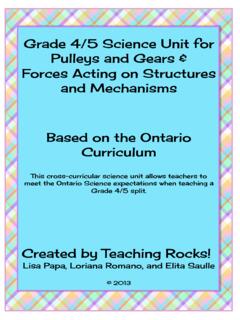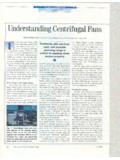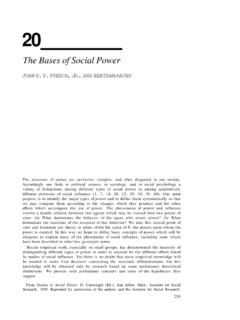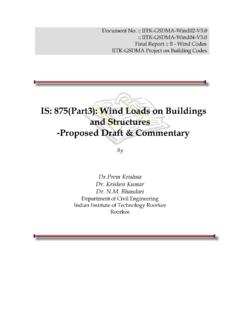Transcription of THERE ARE DIFFERENT TYPES OF FORCES
1 [1] FORCES AND MOTIONTHERE ARE DIFFERENT TYPES OF of the FORCES are more obvious than others and they can be broken down in to two DIFFERENT TYPES : FORCES are what make things move, like a push (kicking a football), or a pull (train)ELECTRICAL FORCES - Static electricity is an example of an electrical force . You will all have noticed that when comb your hair repeatedly that the comb attracts stray strands of hair. Static electricity can cause sparks and crackles if you take off a jumper made from man-made fibres (find out what they are).MAGNETIC force - We all have played with magnets and discovered the invisible force that can either attract or repel another magnet or object made of iron or steel. It is the Earth s magnetic field that we track on a FORCESGRAVITY - Gravity is a force that pulls objects and people towards the Earth. It pushes things down wherever they are, whatever their size.
2 Gravity is the force that gives us weight.[2]MASSThe mass of an object is the amount of matter that is in the object, so mass is related to how much stuff THERE weight of an object is the force OF GRAVITY that acts on that object, so weight is related to the pull of the AND WEIGHTThe mass of an object (measured in Kg) is the same no matter where it islocated in the universe. The weight of an object (measured in Newtons) will vary depending where in the universe it is AND MOTIONCONTACTFORCESFRICTION - This is the force that resists things rubbing against each other. It helps you walk without sliding - except when you walk on the ice, THERE is very little friction and therefore you AND WEIGHTAIR RESISTANCE - This force slows things down when they are moving. Have you ever put your hand out of a car window when you are travelling along? If so you will have felt air resistancePULL (TENSION) - Have you ever had to compete in a tug-of-war competition or had to drag a heavy object?
3 Pulling is a force that we come across every dayPUSH (APPLIED force ) - Again, this is a force that we are all familiar with. Whether you are pushing a bike up a hill or simply shoving a plate across the table - you should be able to think of lots of (SPRING force ) - Whether you are screwing the top off a fizzy drink or turning a tap on to brush your teeth, spring FORCES are ones that you will be familiar with on a daily - This is the force that pushes things up in the water. It helps boats float and keeps swimmers from sinking.(Who am I?)[3]BALANCED AND UNBALANCED FORCESF orces can be described as being balanced or the FORCES on an object are balanced: an object that is not moving will remain stillor an object that is moving continues to move at the same speed and in the same directionIf the FORCES on an object are unbalanced: an object that is not moving starts to moveor an object that is already moving changes speed or directionUNBALANCED FORCES CAUSE CHANGES IN SPEED OR DIRECTIONA ctivity:Have a look at the images in the panel down the side of the page.
4 Name the FORCES illustrated in each image and decide whether the FORCES are either balanced or FORCESF orce is measured in Newtons. A force of one Newton will give a mass of one kilogram, and an acceleration of one metre per second. This means that each second, its speed will increase by one metre per second. When measuring a force , you must state its direction, otherwise you do not know what effect it can show the FORCES acting on an object using a force diagram. In a force diagram, each force is shown as a force arrow. The arrow shows the size of the force (the longer the arrow the bigger the force ) and also the direction in which the force OR UNBALANCEDS teady SpeedStanding StillWhat is the resultant force ?[4] FORCES AND MOTION ACTIVITIESIf you drop an object it will fall to the floor due to the force of gravity. If you place the same object on a a table it will not fall because the table produces an equal force upwards.
5 However, if you place the object on a weak paper support, the support crumples and the object will fall to the floor because the force created by the paper platform is not as strong as the force of gravity. So, when the object is on the table, the FORCES are balanced and when the object is on the paper platform the FORCES are unbalanced (therefore the object moves/changes speed in the direction of the bigger force ).Activity:Push a model car along a table, so that it slows down and eventually stops. What FORCES are acting on the car as it moves and stops? What are the opposing FORCES acting on the model car? When are the FORCES balanced and unbalanced?By reducing air resistance and friction FORCES that act on a car ( stream lining), what effects will these changes have on the speed, the amount of force required to accelerate the car, and fuel consumption of the car?Design activity:Cars which create less friction use less petrol and are therefore less and draw a car, labeling and describing features you have changed to reduce air IN ACTIONLook at the images in the 4 boxes at the side of the page and label them your own pictures in these two boxes showing examples of the following FORCES : Gravity Air Resistance Pull Upthrust Friction PushWRITE THE NAME OF THE FORCES IN THE BOXES:DRAW AND LABEL YOUR OWN ARROWS:SPEEDS peed is calculated by the number of metres travelled per (metres per second) = distance (metres) x time (seconds) the speed of a car which travels 600m in 30 the distance travelled by a horse which runs 1 Kilometre in 4 the time it takes a man running 5m/s to run 450 m[5]HistoryIsaac Newton (1642-1727) was an English physicist, mathematician and astronomer who many people consider to be the greatest scientist of all time.
6 In his book, Principia, published in 1687, he described his 3 laws of motion which have dominated scientific study for over 300 years. English poet Alexander Pope wrote a very famous epitaph for Newton after his death: Nature and nature s laws hid in night; God said let Newton be and all was light. Einstein kept a picture of Newton in his on the MoonGravity is the force that gives us weight. Everything contains a certain amount of material called its mass. When you measure your weight you are really measuring the force of the Earths gravity pulling on your mass. On the Moon your weight would be about one-sixth of your weight on Earth because the Moon s gravity is about one-sixth of the Earth IncidentIt is said that Newton was inspired to write his theory of gravitation after an apple fell from a tree and hit him on the head. This incident made him think about why the apple fell to Earth rather than fly off in another direction.
7 He concluded that: the earth draws and that ..the sum of the drawing power must be in the Earth s centre .3 Laws of MotionFIRST LAW OF MOTIONAn object continues in its state of rest or uniform motion in a straight line unless acted upon by a net external forceSECOND LAW OF MOTIONWhen a net (or unbalanced) force acts on a body, the body is accelerated in the direction of the forceTHIRD LAW OF MOTIONFor every action THERE is an equal and opposite reactionFIRST LAW OF MOTIONGRAVITYTERMINAL VELOCITYThis law is also known as the law of inertia. If FORCES acting on an object are balanced, then:-if it is still, it will stay still-if it is moving, it keeps moving at a constant speed and in a straight lineWhen something falls through the air it feels friction due to air resistance. Because of this, the object will reach a terminal velocity (maximum speed). This is the velocity at which the air resistance balances its weight and so it doesn t speed up but falls at a constant S LAWS OF MOTIONFIRST LAWSECOND LAWTHIRD LAW[6]30 MINUTE STEM ACTIVITYWHY NOT TRY THIS FUN ROCKET EXPERIMENT IN YOUR SCIENCE LESSON OR STEM THIS AT SCHOOLMost rockets create thrust, the force that propels them forward, by an exothermic sure you launch this rocket outside and wear safety goggles.
8 It s very messy and can fly a long way!WHAT YOU NEED:. One plastic specimen tube with a tight push fit lid. One soluble Alka-Seltzer . Water. Safety Goggles. Test tube rackWHAT TO DO:Set up the equipment safety )Break the Alka-Seltzer tablet into 8 pieces2)Put one piece of the tablet into the plastic test tube3)Add 1 or 2 teaspoons of water (5-10ml)DO THE NEXT STEP VERY QUICKLY4)Put the lid on the test tube5)Put the test tube into the test tube rack upside down(Lid on the bottom)6)Stand back 5 METRES. About 10 seconds later you will hear a large pop and your tube will launch in the air (up to 10 metres)CAUTIONIf it does not launch, wait at least 1 minute before examining your rocket. Often the lid might not be on tight enough and the CO2 gas has DOES IT WORK?The water dissolves the tablet and starts a chemical reaction which produces carbon carbon dioxide starts to build up, which increases the pressure inside the tube, until eventually the cap is forced off and the rocket blasts up.
9 This principle of thrust is exactly how real rockets work, only they use rocket fuel instead of Alka- Seltzer INVESTIGATIONHow do the following changes affect the time it takes the rocket to fire and the amount of thrust created? Try using a greater and smaller amount of breaking the tablet into smaller pieces to increase the surface using baking powder and vinegar rather than water and Alka- Seltzer. See if you can get the rocket to go higher by adding fins to the bottom of the tube to increase DOES A JET ENGINE WORK?Front of a turbofan engine Remember Newton s Third Law of Motion?Jet engines create tremendous thrust and can propel aeroplanes with such force that they can achieve speeds in excess of 1000 MPHJet engines (or gas turbine as they are sometimes called) all work in the same way. The engine sucks air into the front with a fan. A compressor raises the pressure and temperature of the air. The compressed air is then sprayed with fuel and an electric spark lights the mixture.
10 The burning gases expand and blast out through the nozzle at the back of the engine, thrusting the aircraft forward. Not all of the air sucked in at the front of the engine goes through the engine. Some of the air flows around the core. This cold air passes through a low pressure compressor and is mixed with the gas generator exhaust to produce a hot jet. The objective of this sort of bypass system is to increase thrust without increasing fuel benefit is that it produces a much quieter jet engine. FAN - The large fan at the front of the engine sucks in large amounts of air. The air is speeded up and split into 2 parts. One part goes through the core or centre of the engine. The second part goes through ducts which surround the core, to the back of the engine where it produces much of the force that propels the aircraft forward. This cooler air quietens the engine as well as add - This is the first part of the engine core.



